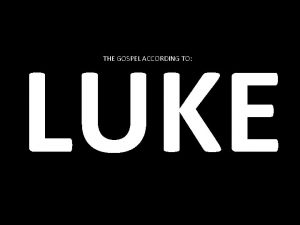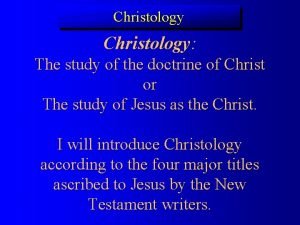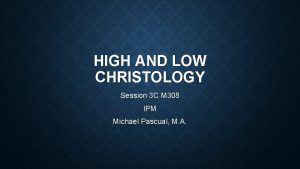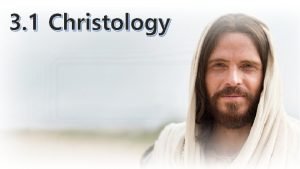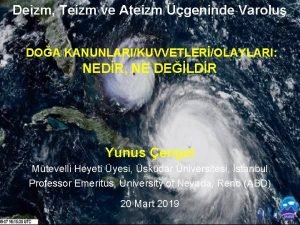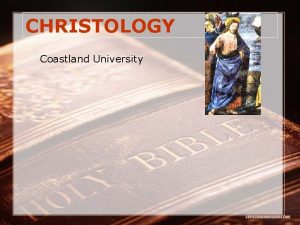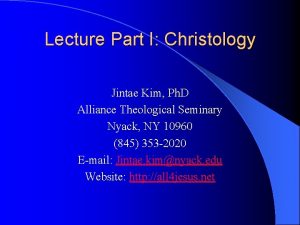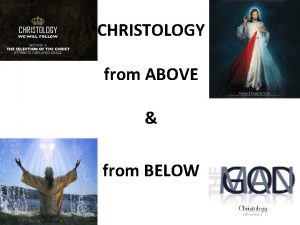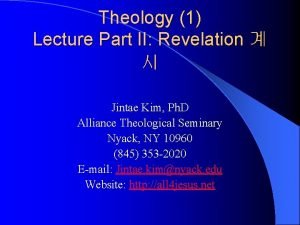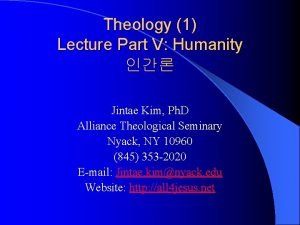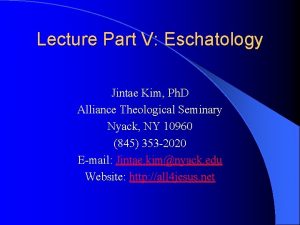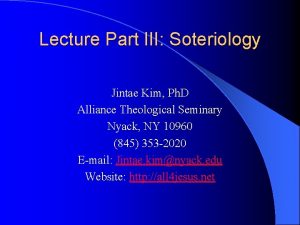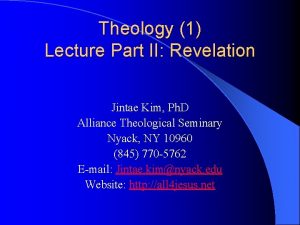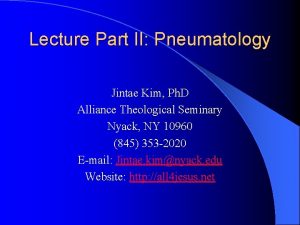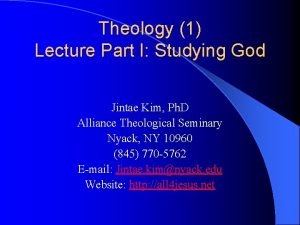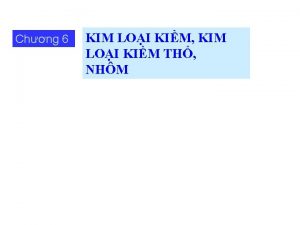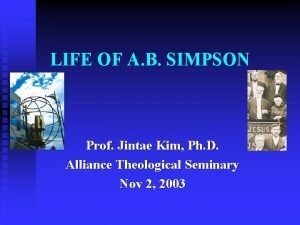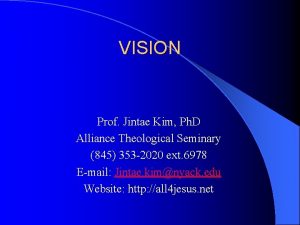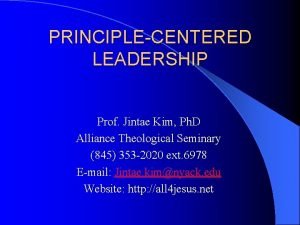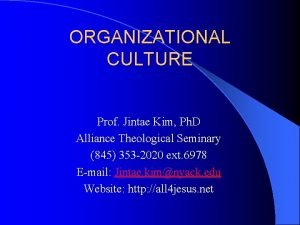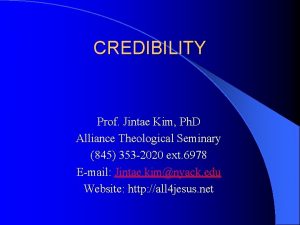Lecture Part I Christology Jintae Kim Ph D




















- Slides: 20

Lecture Part I: Christology Jintae Kim, Ph. D Alliance Theological Seminary Nyack, NY 10960 (845) 353 -2020 E-mail: Jintae. kim@nyack. edu Website: http: //all 4 jesus. net

Trinitarian Unity in Salvation Person God the Father God the Son Ministry Creation and Providence (창조 와 섭리) Redemption (구속사역) God the Holy Spirit Application of the Redemptive Work (구속사역의 적용)

Divine Self-consciousness of Jesus 1. Problem: Not explicit or overt claim, but implicit Claims 2. The Son of man passages: The Son of man and his angels (Matt 13: 41); Authority to forgive sins (Mark 2: 5 -7); Final judge (Matt 25: 31 -33; 26: 6364); The Lord of Sabbath (Mark 2: 27 -28) 3. The Son of God passages (John 5: 18, 21; 19: 7; 20: 31) 4. Unity with God (John 10: 30; 14: 9; 20: 28 -29

Other Evidences for Jesus’ Deity 1. John (1: 1) 2. Hebrews (1: 3, 8, 10; cf. Ps 45: 6; 102: 25 -27) 3. Paul (Col 1: 15 -16; 2: 9; 2 Tim 4: 1; Phil 2: 6) 4. The Term “Lord” (Acts 2: 2 -21; 2 Pet 3: 15; cf. Matt 1: 20; 9: 38; 11: 25; Acts 17: 24; Rev 4: 11) 5. Resurrection

Implication of the Deity of Christ (Erickson, 213) l We can have a real knowledge of God. l Redemption is available to us. l God and humanity have been reunited. l Worship of Christ is appropriate.

Biblical Evidence of Humanity of Christ 1. Physical human nature (Luke 2: 52; Matt 4: 2; John 4: 2, 6; 19: 34). 인간의 육신. 2. Psychological human nature (John 11: 3335; 13: 23; 15: 11; 17: 13; Matt 26: 37; Mark 3: 5; 10: 14; Luke 7: 9; Mark 6: 6; 15: 34) 인간 의 정신.


Implication of Humanity of Jesus (Erickson, 222 -3) 1. The atoning death of Jesus can truly avail for us. 2. Jesus can truly sympathize with and intercede for us (Heb 4: 15). 3. Jesus manifests the true nature of humanity. 4. Jesus can be our example. 5. Human nature is good. 6. God is not totally transcendent. He is not so far removed from the human race.

Biblical Evidence for the Unity of the Person of Christ Category Content Scripture Person Always refers John 1: 14; Gal 4: 4; 1 Tim to one entity 3: 16 Ministry Of One Person 1 John 2: 1 -2; 4: 15; 5: 5; Col 1: 13; John 3: 13; 6: 62

Hypostatic Union l The doctrine of the hypostatic union, first set forth officially in the definition of faith produced by the Council of Chalcedon (451), concerns the union of the two natures of deity and humanity in the one hypostasis or person of Jesus Christ. In the incarnation of the Son of God, a human nature was inseparably united forever with the divine nature in the one person of Jesus Christ, yet with the two natures remaining distinct, wholly, and unchanged, without mixture or confusion so that the one person, Jesus Christ, is truly God and truly man.

Basic Tenets of the Doctrine of Two Natures in One Person (Erickson, 228 -31) 1. The incarnation was more a gaining of human attributes than a giving up of divine attributes. 2. The union of the two natures meant that they did not function independently. 3. The humanity of Christ is a true humanity that we must have had. Christ is the true human, while we are of depraved human. 4. The incarnation was not an impossible task because it was initiated by God. 5. It is also helpful to think of Jesus as a very complex person.

The Stages of Christ’s Work 1. Humiliation: Incarnation (John 1: 14; Phil 2: 6 -8; Gal 4: 4) Death *Descent into Hades (Ps 16: 10; Eph 4: 8 -10; 1 Tim 3: 16; 1 Pet 3: 18 -19; 4: 46) 2. Exaltation: Resurrection Ascension and Session at the Right Hand of the Father (John 6: 62; 14: 2; 16: 5, 10, 28; 20: 17; Luke 24: 50 -51; Acts 1: 6 -11; Eph 1: 20; 4: 8 -10; 1 Tim 3: 16; Heb 1: 3; 4: 14; 9: 24) Second Coming.

The Functions of Christ (Calvin) 1. The Revelatory (Prophetic) Role of Christ (Matt 13: 52; 21: 11, 46; Luke 24: 19; John 1: 8; 6: 14; 7: 40; 14: 9; Acts 3: 22 ; cf. Deut 18: 15). 2. The Kingly Role of Christ (Heb 1: 8; John 1: 3; Col 1: 17, 18; cf. Isa 9: 7) 3. The Reconciling (Priestly) Work of Christ: Atonement and Intercession.

Views on the Atonement Theory Content Socinian Theory Example – denied vicarious satisfaction (cf. 1 Pet 2: 21). Moral Influence Theory Demonstration of God’s Love – denied for necessity of atoning sacrifice – Peter Abelard; Horace Bushnell. Governmental Theory Demonstration of Divine Justice – Hugo Grotius. Ransom Theory Victory over the Forces of Sin and Evil (1 Cor 6: 20; Matt 20; 28) – Origen, Irenaeus, Gregory of Nissa, Augustine. Satisfaction Theory Compensation to the Father – Anselm

Background Factors of Atonement (Erickson, 246 -8) 1. Divine nature: Perfect and holy 완전하고 거룩 2. Legal status: Sin Death 죄의 삯은 사망 l 인간의 전적 타락 Human condition: Total depravity or inability 할 수 없는 것을 3. Christ as God-man (Gal 4: 4 -5) 4. 예표: The OT Sacrificial System (Lev 1: 4; Isa 53: 6) 구약의 제사제도.

l “Such passages as Hebrews 1: 1 -3; 2: 9 -18; 9: 9 -14; 22 -28 teach very plainly that the efficacy of Christ’ work is contingent upon the unique constitution of Christ’ person…. It is this consideration that gives such strength to the necessity, spoken of in 9: 23, to the effect that while the patterns of things in the heavenlies should be purified with the blood of goats and calves, the heavenly things themselves should be purified by the blood of none other than the Son. In other words, there is stated to be a necessity that can be met by nothing less than the blood of Jesus. But the blood of Jesus is blood that has the requisite efficacy and virtue only by reason of the fact that he who is the Son, the effulgency of the Father’s glory and the express image of his substance, became himself also partaker of flesh and blood and thus was able by one sacrifice to perfect all those who are sanctified” (Murrary 1955: 14).

NT Teachings on Atonement l Gospels (John 1: 29; 3: 17; Luke 22: 37; Matt 16: 21; 20: 28) l Pauline (Rom 3: 25; 5: 9; Eph 1: 7; Col 1: 20)

Basic Meaning of Atonement Meaning Sacrifice Explanation 속죄제물 Propitiation 하나님의 진노를 만족- Angry God? Scripture Heb 9: 11 -12, 28 Rom 1: 18; 4: 15; 5: 9; Eph 2: 3 -5; 1 Thes 1: 10 Substitution 대속. 우리의 죄가 Gal 3: 13; 1 Pet 그리스도에게 전가 2: 24; 1 Tim 2: 6; 됨. cf. Isa 53: 6 Reconcilia- 하나님과의 화목을 Rom 11: 15; 3: 25; tion 가져다 줌. 5: 10 -11

Objections to the Penal Substitution Theory (Erickson, 254) 1. To the concept of the necessity of atonement: Why doesn’t God simply forgive man? 왜 성가시게 속 죄가 필요한가? 2. To the concept of substitution: Is it fair? 불공평하 지 않은가? 왜 죄없는 자가 죄인의 죄를 덮어쓰 는가? 3. To the concept of propitiation: How can the loving God be angry? 사랑의 하나님과 진노의 하나님? 4. To the concept of imputation of Christ’s righteousness 그리스도의 의가 어떻게 우리에게 전가될 수 있는가? 말이 안된다.

Implication of Substitutionary Atonement (Erickson, 254 -5)
 01:640:244 lecture notes - lecture 15: plat, idah, farad
01:640:244 lecture notes - lecture 15: plat, idah, farad Christology definition
Christology definition Ascending christology meaning
Ascending christology meaning Low christology
Low christology What is christology?
What is christology? Low christology examples
Low christology examples What is christiology
What is christiology Christology in telugu
Christology in telugu Part part whole
Part part whole Part to part variation
Part to part variation Technical description
Technical description Part whole model subtraction
Part whole model subtraction Layout dispense bar diagram
Layout dispense bar diagram Part to part ratio definition
Part to part ratio definition The phase of the moon you see depends on ______.
The phase of the moon you see depends on ______. Doa evren kimdir
Doa evren kimdir Junni kim
Junni kim Kim hazelwood
Kim hazelwood Köktürk yazıtları
Köktürk yazıtları Kim rodriguez age
Kim rodriguez age Kim były syreny
Kim były syreny



